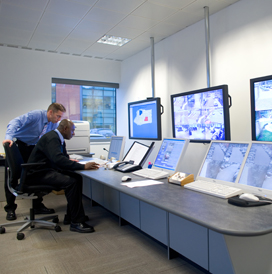Why integrate fire safety and security? Against the backdrop of today’s challenges, we have to protect vital assets, writes Siemens.
Starting at the perimeter, use of CCTV and automatic number plate recognition technologies are now widespread. The restriction of physical access and perimeter protection are alternative ways of deterring unauthorised intrusion. And by integrating access control to restrict access to specific areas, cameras can be even more intuitive by adding enhanced technology such as video analytics to obtain greater information and intelligence.
Moving inside, internal CCTV is utilised for asset protection and passive infrared for people detection. Higher areas of risk may demand enhanced detection such as biometric devices. For more intelligent systems video analytics is increasingly used for spatial awareness. Building entry points are vulnerable and anomaly detection for both people and vehicles can be used to improve security. Often technology is only part of the solution; people behaviours also need to be addressed.
Convergence of physical and logical access can now be provided by single card sign-on, resulting in improved people identity systems and other benefits such as cashless vending and asset tagging.
It is essential that fire detection systems minimise the risk of false alarms as the consequences in this environment can be catastrophic. Once again devices need to be more intelligent, meaning decision-making is made within the device and not the panel. Multiple and simultaneous sensors mean zero false alarms.
Mass evacuation recognises the need for greater control during a major incident, offering controlled evacuation where selected floors are evacuated, while simultaneously alerting others. Evidence has shown that multiple alerts are more effective, so combining audio with media like SMS can prove extremely effective. For people protection, legislation demands clear evacuation procedures, which can be supported from public address and voice evacuation systems. For compliance, organisations must ensure the safety of people, so lone worker technology can also be deployed.
In sensitive environments such as computer room, asset protection will also require some form of gas suppression system.
Integration of fire safety with security
By integrating fire and security we can take a much more holistic approach to command and control. We then decide which technologies to converge to deliver improved cost and manpower efficiencies.
To illustrate integration, let’s consider a simple scenario: a control system informs operators of an alarm indicating the activation of a smoke detector. With greater access to a wider range of resources to manage the situation they can now progress vital decisions:
•Do we release gas extinguishing systems across critical data storage areas?
•What other resources do we need to manage?
•Is there a need to deploy the fire service?
•What is the risk to personnel across the site?
These activities can be centralised to reduce cost, but centralisation places greater importance on effective communication as geographic boundaries are extended.
Human error must be mitigated, making decision-making more systematic and the need to follow a logical workflow more important. An integration platform will communicate in real time with each data point to enable:
•triggers to alert operators of an incident
•tools to help understand the specific local issues
•workflow to guide personnel through a logical investigation with appropriate measures and actions
•monitoring of all sub-systems for both operational issues and availability
•procedures that demonstrate compliance for future audits
•resource allocation dependent on the situation
•constant situational analysis to provide a feedback loop
•a summary report which captures the whole event
For many operations, time is critical, so operators need information at their fingertips. Integration of fire and security brings a decision management workflow that assigns priorities, determines resources and allows them to assign appropriate actions and resources.










